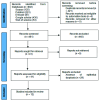Expression of Ki-67 in Oral Lichen Planus: A Systematic Review and Meta-Analysis
- PMID: 39713114
- PMCID: PMC11662169
- DOI: 10.30476/dentjods.2023.98491.2082
Expression of Ki-67 in Oral Lichen Planus: A Systematic Review and Meta-Analysis
Abstract
Statement of the problem: One of the main signs of cancer development is increasing of cell proliferation activity. Expression of the Ki-67 as a cell proliferation marker is extensively utilized in pathology studies as an indicator of proliferation in human tumors. According to studies, Ki-67 plays an effective role in the pathology of malignant and pre-malignant oral mucosa lesions.
Purpose: The current study aimed to systematically review the Ki-67 expression in oral lichen planus without dysplasia and compare it with oral epithelial dysplasia.
Materials and method: In this meta-analysis, all articles in the English language were searched in databases including Web of Science, PubMed, Embase, Scopus, and Google Scholar until July 2023. MeSH terms and free keywords were used in the search step. Expression of Ki-67 in oral lichen planus and oral epithelial dysplasia was analyzed by Comprehensive Meta-Analysis software.
Results: Nine hundred and two articles related to the searched words were found. According to the selection criteria, 12 retrospective articles were selected. Low quality was not observed in any of the records by the Newcastle-Ottawa scale and most of them had a relatively good quality. Totally, 593 patients were examined. The heterogeneity between studies was not significant. The meta-analysis results indicated a significantly lower Ki-67 expression in oral lichen planus without dysplasia in comparison to oral epithelial dysplasia.
Conclusion: The more intense expression level of Ki-67 in oral epithelial dysplasia compared with oral lichen planus was observed. The ki-67 expression could be utilized to indicate the existence and intensity of epithelial dysplasia and disease progression.
Keywords: Ki-67 antigen; Lichen planus; Oral; Prognosis.
Copyright: © Journal of Dentistry.
Conflict of interest statement
The authors have declared that no conflict of interest exists.
Figures
Similar articles
-
An exotic pathogenetic mechanism of angiogenesis in oral lichen planus-A systematic review.J Oral Pathol Med. 2023 Oct;52(9):803-810. doi: 10.1111/jop.13472. Epub 2023 Aug 8. J Oral Pathol Med. 2023. PMID: 37553286 Review.
-
Comparative analysis of cell proliferation ratio in oral lichen planus, epithelial dysplasia and oral squamous cell carcinoma.Med Oral Patol Oral Cir Bucal. 2009 Nov 1;14(11):e563-7. doi: 10.4317/medoral.14.e563. Med Oral Patol Oral Cir Bucal. 2009. PMID: 19680198
-
Evaluation of Potential Risk Factors that contribute to Malignant Transformation of Oral Lichen Planus: A Literature Review.J Contemp Dent Pract. 2016 Aug 1;17(8):692-701. doi: 10.5005/jp-journals-10024-1914. J Contemp Dent Pract. 2016. PMID: 27659090 Review.
-
Worldwide prevalence of oral lichen planus: A systematic review and meta-analysis.Oral Dis. 2021 May;27(4):813-828. doi: 10.1111/odi.13323. Epub 2020 Apr 2. Oral Dis. 2021. PMID: 32144836
-
Estimation of malignant transformation rate in cases of oral epithelial dysplasia and lichen planus using immunohistochemical expression of Ki-67, p53, BCL-2, and BAX markers.Dent Res J (Isfahan). 2015 May-Jun;12(3):235-42. Dent Res J (Isfahan). 2015. PMID: 26005463 Free PMC article.
References
-
- Gholizadeh N, Mehdipour M, Dadgar E, Bahramian A, Moghaddas DE. Immunohistochemical Evaluation of Ki-67 Expression in Erosive and Non-Erosive Oral Lichen Planus. Avicenna J Dent Res. 2016; 8: 1.
-
- Motahari P, Pournaghi Azar F, Rasouly P. Association of interferon-gamma gene polymorphism (+874 A/T) and oral lichen planus susceptibility: Systematic review and meta-analysis. Jorjani Biomed J. 2019; 7: 45–55.
-
- Sugerman PB, Sabage N. Oral lichen planus: causes, diagnosis and management. Aust Dent J. 2002; 47: 290–297. - PubMed
Publication types
LinkOut - more resources
Full Text Sources
Research Materials


